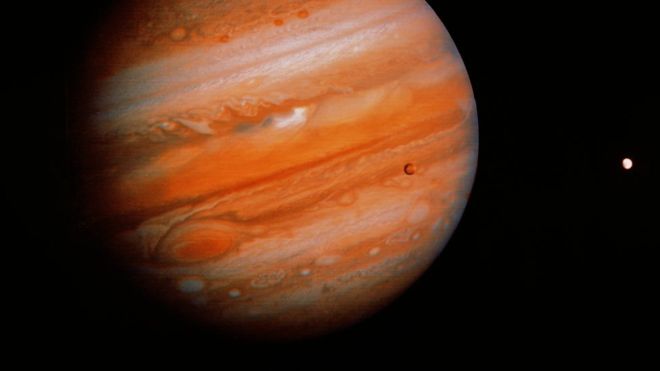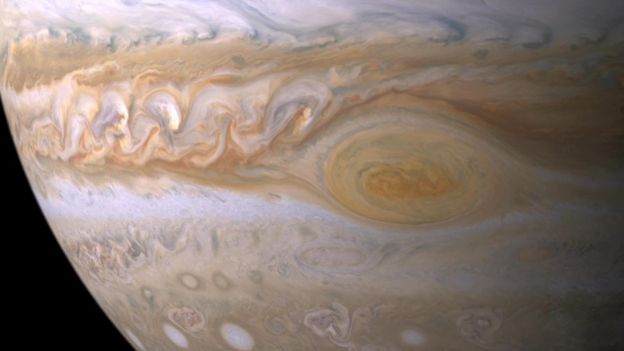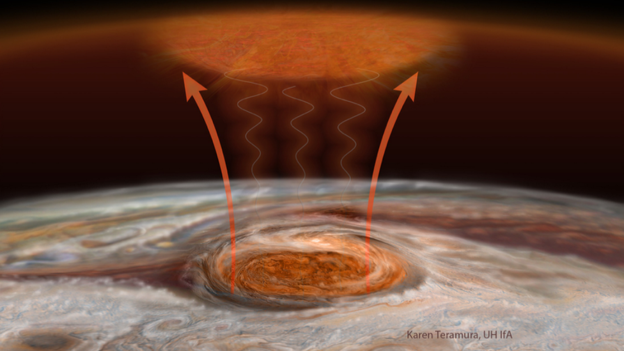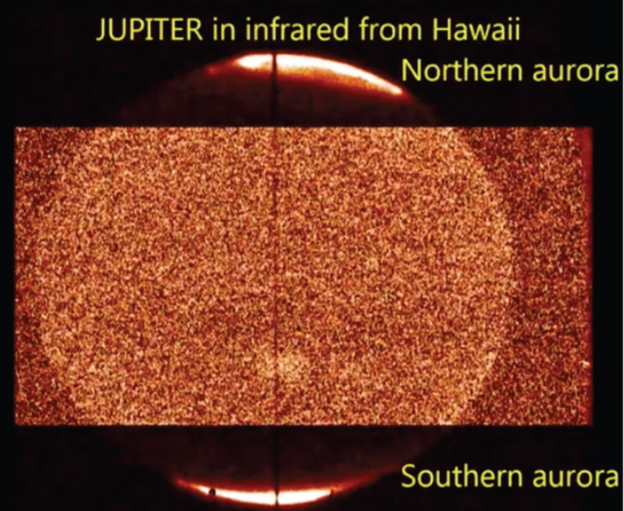Jupiter’s Great Red Spot ‘roars with heat’

Jupiter's Great Red Spot — a hurricane three times bigger than Earth — is blasting the planet's upper atmosphere with heat, astronomers have found.
Using measurements from an infrared telescope in Hawaii, a UK and US team found evidence for temperatures as high as 1,500C — hundreds of degrees warmer than anywhere else on the planet.
They suggest the hotspot is created by thunderous soundwaves "breaking" in the thin upper reaches of the atmosphere.
The research is published in Nature.
It arguably solves what planetary scientists had dubbed an "energy crisis" for gas giants like Jupiter: temperatures in their upper atmospheres soar much higher than can be explained by solar energy — especially given their vast distances from the Sun.
If the mysterious heat were generated by local sources, like Jupiter's famous storm, then the conundrum would be solved — and these measurements are the first direct evidence of any such activity.
Study co-author Dr Tom Stallard, from the University of Leicester, said this was a major step forward in a "20-30 year odyssey" to try and understand heat flow on Jupiter.
"Ever since Voyager, we've had measurements of the temperature at the top of Jupiter's atmosphere, and it's been hot across the whole globe — from the poles, all the way to the equator," he told the BBC.
Jupiter's enormous, dramatic aurora can explain the heat in the polar regions, but for that warmth to reach the equator would require incredibly dramatic mixing, which modelling studies haven't been able to support.
"There's no real excuse for it to be so hot," said Dr James O'Donoghue from Boston University, the paper's first author.
Sound and fury
The freshly discovered spike in temperature, detected using a spectrometer at the Nasa Infrared Telescope Facility (IRTF) in Mauna Kea, Hawaii, offers a solution.
Several hundred km directly above the clouds of the Great Red Spot, the hotspot suggests that high-altitude heat is somehow created by the turmoil beneath.
"Several people have argued that it's likely that the heat comes from below, but the observations have never backed them up," Dr Stallard said.
He and his colleagues don't know exactly what is causing the heat, but they have some ideas. It could be driven by devastating Jovian thunderclaps, rumbling upwards from the churning red clouds of the Solar System's biggest storm.
"You get some kind of acoustic event, probably thunder or something like that — or possibly other forms of sound energy — and that propagates directly upwards," Dr Stallard explained.
"That wave will continue going upwards until it reaches a lower-density region at the top of the atmosphere, and then it breaks and deposits all that wave energy into the top of the atmosphere, just like waves break on the shore — as the water gets thinner, it's less able to carry that wave and so it breaks and you see lots of energy."
There is a precedent for such sound-driven warming much closer to home, according to Dr O'Donoghue.
"There is some evidence in Earth's atmosphere, above storms and above features such as mountains — the Andes mountains in fact — that there are acoustic waves emanating from them, and that they propagate up into the atmosphere and cause heating there," he said.
Ionic thermometer
The key to revealing the temperature spike was a tiny ion: H3+, or protonated hydrogen. It is incredibly reactive and usually short-lived, but in the sparse fringe of Jupiter's outer atmosphere there is almost nothing else for it to react with.
Crucially, this ion works like a glowing, long-range thermometer for scientists, if they have the right sort of telescope — such as the spectrometer at the IRTF, which gathered the relevant data in a single nine-hour window back in 2012.
"Just by measuring its light, you can find out the temperature wherever it is," said Dr O'Donoghue. "And it's throughout all of the gas giant upper atmospheres — so it's essentially an in situ temperature probe."
Further insights might come from Nasa's Juno spacecraft, now in orbit around Jupiter after its five-year trek.
Dr Stallard said that telescopes around the world were trained on the gas giant to take parallel measurements — and his team had planned their observations with the mission in mind.
"We thought, this is something that we haven't addressed, and it needed addressing. We've really ramped up our studies away from the aurora.
"Juno's going to reveal magnificent levels of detail about… what the aurora are and how they're generated. But it will be interesting to see how much it tells us about the non-auroral regions and the top of the atmosphere.
"Obviously it's been designed to look deep, and to look at the aurora at the poles, but potentially Juno could reveal a lot more."
Follow Jonathan on Twitter
Политика конфиденциальности | Правила пользования сайтом










